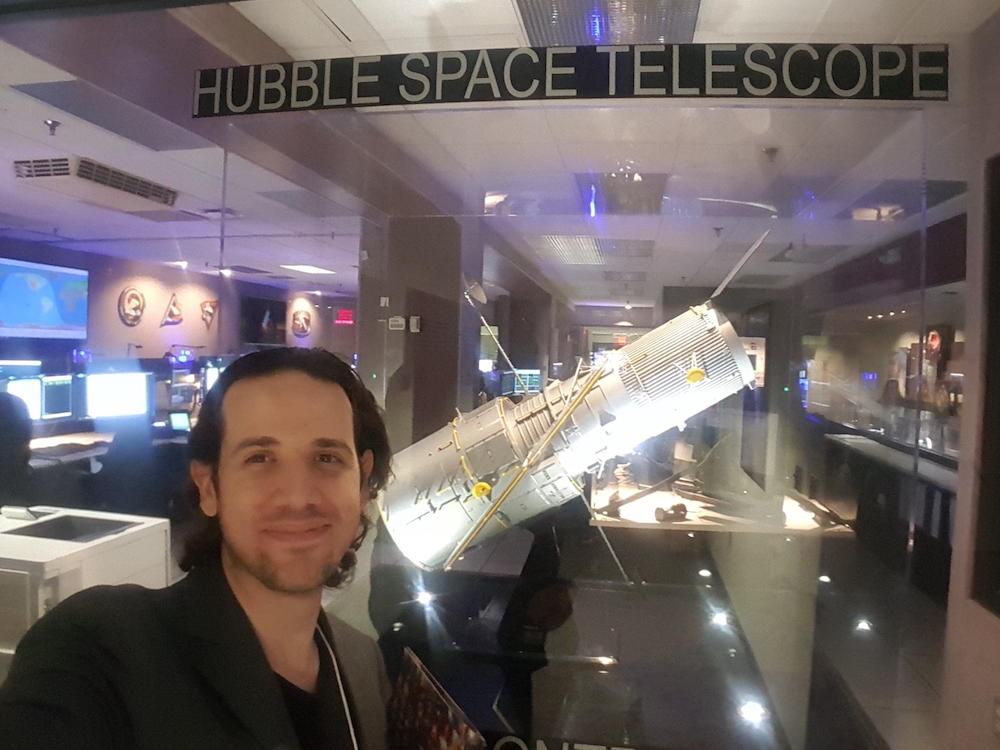About Me
 Greeting! I am a postdoc fellow working at NASA Ames with Dr. Mark Marley. I enjoy doing fundamental and
interdiciplinary science which explains why I had my education focused on chemistry and atmospheric astronomy.
This is why I called myself ExoAtmoSpectroscopist.
Greeting! I am a postdoc fellow working at NASA Ames with Dr. Mark Marley. I enjoy doing fundamental and
interdiciplinary science which explains why I had my education focused on chemistry and atmospheric astronomy.
This is why I called myself ExoAtmoSpectroscopist.
Publication
Peer-edited papers:
- E. Gharib-Nezhad, M. Marley, C. Visscher, and N. Batalha
“The chemistry of Li-bearing Molecules in Brown-dwarf Atmospheres”,
In Preperation, 2021.
- E. Gharib-Nezhad, A. Iyer, M. Line, R. Freedman, M. Marley, and N. Batalha
“EXOPLINES: MolecularOpacities for Brown-Dwarf and Giant Exoplanet Atmospheres”
In Revision in APJS, 2021.
- E. Gharib-Nezhad, A.N. Heays, H.A. Bectel, and J.R. Lyons
“H2-Induced Pressure Broadening and Pressure Shift in the P-Branch of the ν3 Band of CH4 from 300 to 655 K”,
JQSRT, 239, 106649.2019. Link
- E. Gharib-Nezhad, M. R. Line
“The Influence of H2O Pressure Broadening in High-Metallicity Exoplanet Atmospheres”,
ApJ, 872, 27.2019 Link
- J. Fortney, T.D. Robinson, S. Domagal-Goldman et al.
“The Need for Laboratory Measurements and Ab InitioStudies to Aid Understanding of Exoplanetary Atmospheres.”,
arXiv:1905.07064.2019.Link
- J. R. Lyons, E. Gharib-Nezhad & T.R. Ayres,
“Carbon isotope composition of the solar photosphere”,
Nature Communication 9, 908.2018A.Link
- Shayesteh, S. F. Alavi, M. Rahman, E. Gharib-Nezhad
“Ab initio transition dipole moments and potentialenergy curves for the low-lying electronic states of CaH”,
, Chem. Phys. Lett., 667 , 345.2017. Link
- E. GharibNezhad, A. Shayesteh & P. F. Bernath,
“Einstein A coefficients for rovibronic lines of the A2Π→X2Σ+and B′2Σ+→X2Σ+transitions of MgH”,
MNRAS, 432, 2043.2013. Link
- E. GharibNezhad, A. Shayesteh & P. F. Bernath,
“Fourier transform emission spectra of the A2Π→X2Σ+and B2Σ+→X2Σ+transitions of CaD”,
J. Molec. Spec., 281, 47.2012. Link
Selected Talks:
- “H2-induced pressure broadening and pressure shift in the P-branch of the ν3 band of CH4 from 300 to 655 K”,
Int. Symp. Molec. Spec., IL.2019.
- “Opacity Data: The Need for Laboratory Measurements to Interpret Observational data”,
Bay Area ExoplanetsMeeting2019.
- “The influence of pressure broadening on Exoplanet Spectra”,
Other Worlds Laboratory (OWL), CA.2018
- “H2broadening in theν3andν4bands of CH4at room temperature”,
Int. Symp. Molec. Spec., IL.2018
- “The Influence of Pressure Broadening on Exoplanet Atmosphere Spectra”,
NASA Ames, CA.2018
- “Simulating exoplanet hazes with high temperature discharge experiments”,
APS, AZ.2016
Selected Conference Abstracts:
- E. Gharib-Nezhad, M.R. Line & J. R. Lyons,
“Effect of Pressure Broadening on Emission and TransmissionSpectra of H2O Modeled for sub-Neptune/super-Earth exoplanets: An Application to JWST”
DPS49, Abstractid:149.19.2017J.
- R. Lyons,E. Gharib-Nezhad& T. R. Ayres,
“The Carbon Isotope Composition of the Sun”,
48th LPSC,id.2309.2017
- E. Gharib-Nezhad, J. R. Lyons & D. P. Wright,
“Laboratory Simulation of Haze/Aerosol formation in warmand hot Jupiters”
DPS48/EPSC11, Abstract id:122.05.2017
- E. GharibNezhad, J. R. Lyons & D. P. Wright
“Simulating Haze Particles in a H2-Rich Exoplanet Atmospherewith High Temperature Discharge Experiments”,
LPS, Abstract# 2565.2016
Research
Computing Opacity Data
Understanding the composition of exoplanetary atmospheresis the main objectives in exoplanetary science.
In order to properly interpret observationaldata from either space-based telescopes or Earth-based observatories,
we need to carry outthe radiative transfer modeling of exoplanetary atmospheres. The accuracy of the radiativetransfer modeling
results depends upon the accuracy of molecular opacity data data. Opacities are strongly dependent on temperature,
pressure, and background gases (broadeners).
Laboratory Spectroscopy
Using the Bruker IFS 125HR spectrometer in LawrenceBerkeley National Laboratory, the high-resolution transmission
spectra of CH4in H2bathgas are recorded forν3band at 300–700K. Since this is one of my primary dissertationprojects,
I had the leading role in developing the experimental details including simulatingthe expected IR spectra, calculating
the appropriate pressures of CH4and H2, and alsodiscussing the project details with my PhD advisers, my collaborators,
and the beamlinescientist at Lawrence Berkeley National Laboratory who is in charge of Bruker 125HR spec-trometer.
More than 200 lines are analyzed to extract the pressure-broadening coefficients(i.e., Lorentzian and
temperature-dependence). We found that Lorentzian coefficients are inthe range of 0.055–0.08 cm−1/atm, and are
strongly dependent on the rotational quantumnumbers J and on the symmetry of the transition.
The results are important in modelinghot-Jupiters and classifying T-dwarfs
Atmospheric Modelings
Fully capitalizing on the information encoded in a spectrum requires a robust model interpretation.
Models used to interpret thermal emission spectra (either from an isolated object like a brown dwarf,
M-dwarf, or directly imaged planet, or a secondary eclipse spectrum for a transiting planet)
and transmission spectra (for transiting planets) require some combination of chemistry and
radiative transfer. Self-consistent models (either 1D or 3D) rely upon a detailed coupling between
chemical processes (e.g., thermochemical equilibrium or chemical kinetics/photochemistry),
radiative energy transport, convective/dynamical energy transport, and cloud/haze processes
to determine the atmospheric state and subsequent observables. Retrieval models, on the other hand,
are purely data-driven and attempt to leverage large numbers of free parameters
(e.g., molecular abundances for select species, temperature profile parameterization)
to adequately fit the observables to determine Bayesian constraints on composition, clouds,
and thermal structures \citep{Line2014}. The adequacy of these methods, whether for predictions or
parameter estimation, relies upon accurate and complete molecular and atomic opacities.
Contact
I am always happy to chat about new ideas with colleagues and collaborate.
Please feel free to contact me!
Email:Ehsan.GharibNezhad@NASA.Gov
 Greeting! I am a postdoc fellow working at NASA Ames with Dr. Mark Marley. I enjoy doing fundamental and
interdiciplinary science which explains why I had my education focused on chemistry and atmospheric astronomy.
This is why I called myself ExoAtmoSpectroscopist.
Greeting! I am a postdoc fellow working at NASA Ames with Dr. Mark Marley. I enjoy doing fundamental and
interdiciplinary science which explains why I had my education focused on chemistry and atmospheric astronomy.
This is why I called myself ExoAtmoSpectroscopist.
